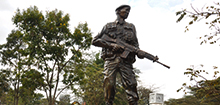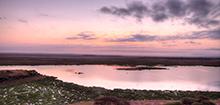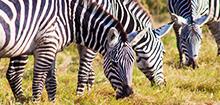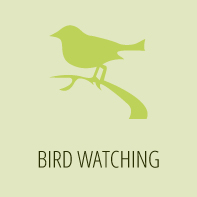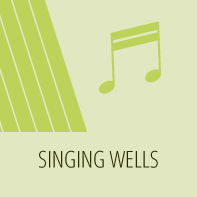"A remote paradise for nature lovers"
Mountainous, misty yet effortlessly breathtaking, this park features a dense montane forest and three crater lakes that provide a haven for a variety of birdlife, mammals and reptiles. The forested mountain rises spectacularly from the middle of a desert wilderness and provides the only source of permanent surface water in the region.
The park is a refuge for the huge tusked bull elephants and the most famous elephant named Ahmed was his home until he died at an estimated age of 63 years. A model of elephant Ahmed now stands tall at the National Museum of Kenya in Nairobi.
The extinct volcanic craters locally known as gofs around the Park make Marsabit such a wonderland. Located on the eastern side of the Park, Gof Bongole is the largest and the stagiest of the craters with a dizzying 10 kilometer round rim. The natural amphitheater of Gof Sokorte Guda has a 150 meters high caldera that shelters the fresh waters of Lake Paradise. Most of these craters are home to a diverse number of bird species.
Originally, part of this park took in Shaba, Samburu, Buffalo Springs and the Losai National Reserve, the park was designated a national reserve in its own right. It was a nomadic rangeland and the drought land of the Rendille herdsmen. Its name means “Mountain of Cold”.
The park is an overflowing adventure destination depicting an array of endless activity options awaiting the nature enthusiasts. Sometimes the only therapy the human mind, body and soul craves and thirsts for is the simple yet magically refreshing moments in the quietude of space and time just sitting in pin drop silence, well, save for the in-between chirping bird sounds, trumpeting away elephants. Watching the sunrise and sunset, a flower bud determined to pop open, a chatty bird drinking from the fountain of some wild nectar, a static colorful butterfly perched on lush flower buds, daydreaming and a ton of little thrilling moments.
Interesting to see is the Marsabit Cultural Museum & Information Center. The facility acts as an education center disseminating information about the park and culture of the locals. The museum preserves bits and pieces of a rich culture, traditions of the people of the larger northern Kenya, their tools of trade and traditional regalia. The space also hosts a gallery of several mounted images of wildlife in the park and the local people. These images are captured, and donated by individuals and organizations in support of conservation efforts in Kenya, to display a beautiful blend of culture, wildlife and scenic landscapes.
Marsabit County is home to over ten different communities, each with a unique and pristine culture. These include; the larger pastoralist communities such as Borana, Gabbra, Rendille, Turkana, Somali, Samburu and the lesser known agro-pastoralists, skilled black smiths, hunters and gatherers such as, but not limited to the Burji, Saakuye, Konso, Waata, Garri, Sidama and Dasanach.
A visit to the park is not complete without a short trip to the singing wells. The wells feature a shared animal watering point for both domestic and wild animals. Herdsmen bring their animals to the well where they go down to fetch water filling the water troughs, and as the animals quench, the men break into songs and choruses that infiltrate into the air; thus ‘singing wells’.
Visitors can enjoy hikes in the dense forest with a closed high canopy wreathed in mist, camel rides, and bird watching, bush trekking, camping and visit to the singing wells, Lake Paradise and Elephant pool.
Altitude: 1,000-5,000FT
Area: 360 sq.km
Location: Marsabit County
Gazettement: 1967
Distance from Nairobi: 530 KM
Key features
Wildlife
- Elephants, buffalo, greater/lesser Kudu, hyena, Grevy’s zebra, Kirk’s dik-dik, reticulated giraffe, lion, leopard and baboon.
Protected Area Type
Park Size
Climate
When to go
What to take with you
- Drinking water, picnic items and camping equipment if you intend to stay overnight.
- Also useful are: binoculars, camera, hat, sunscreen, sunglasses and guidebooks
How to get there
- Distance: 530 km north of Nairobi. 263 km north of Isiolo.
- Gates: 2 Gates; Ahmed with an exit at Karare, and Abdul to the park headquarters
- Roads: from Nairobi, the reserve is reached via Nanyuki and lsiolo a distance of 530 km. The road is paved up to Merille leaving a distance of 120 km of murram road that is only motor-able by 4 wheel-drive vehicles during the dry season.
- Airstrips: there is an airstrip at Marsabit, 4km from the Park’s main gate.
- By Air: The reserve is 2 hrs by air from Nairobi and is adequately served by a tarmac airstrip located about one kilometer from Marsabit town centre.
Attractions
- Three craters
- Lake paradise
- Last refuge of the huge-tusked bull elephants
- Pristine Forest
- Diverse birdlife
- A variety butterfly
Park Entry Fee
Marsabit National Park & Reserve | Citizen | Resident | Non-Resident | |||
Adults KSH | Child KSH | Adult KSH | Child KSH | Adult USD | Child USD | |
300 | 215 | 300 | 215 | 22 | 13 | |
* Kindly refer to the Conservation Fees document below for other services and charges.
* Mode of payment; Pay for your entry to any of our Parks or Reserves via eCitizen government platform.
* Create a personal account on the eCitizen Government platform by visiting https://kws.ecitizen.go.ke and make park payments in advance for a fast and convenient park entry.
Park Resources
Phone:
Tel: +254 115224276
Email: marsabitnp@kws.go.ke
Postal Address:
The Warden
Marsabit National Park
PO Box 42,
Marsabit, Kenya.

